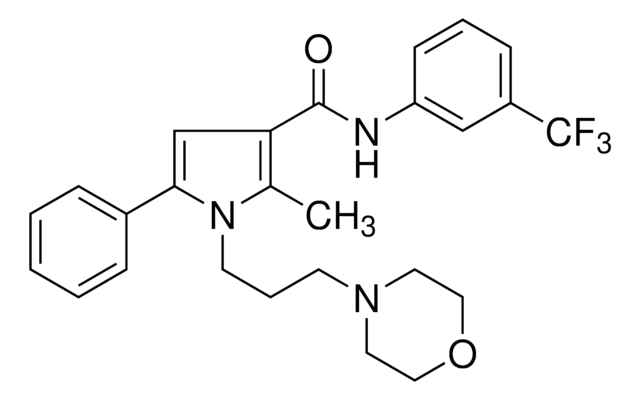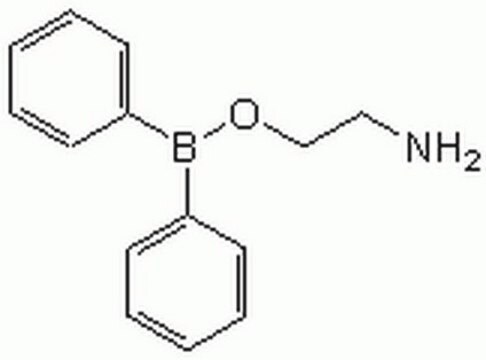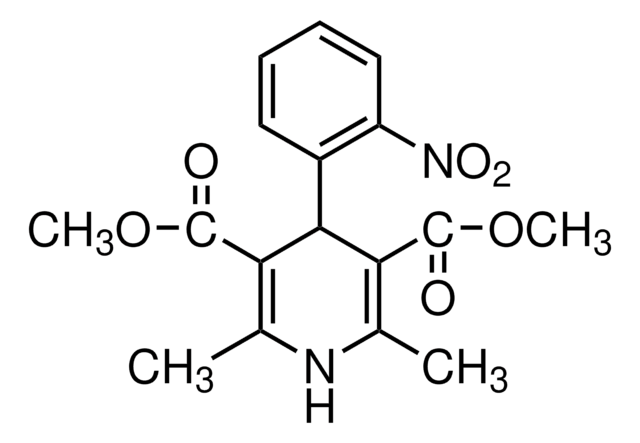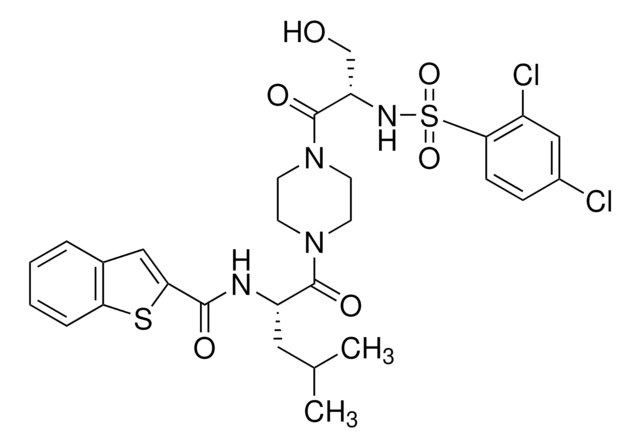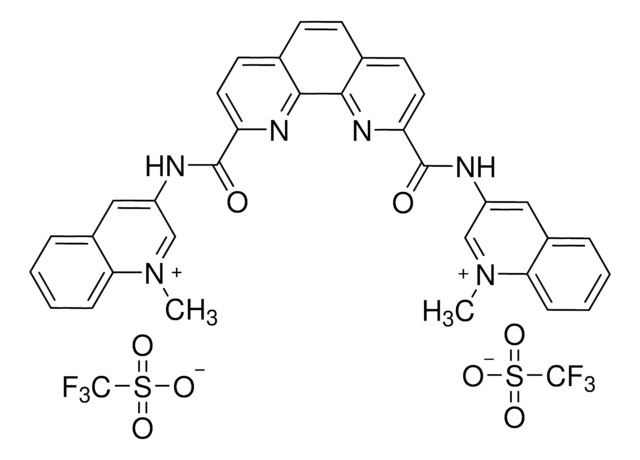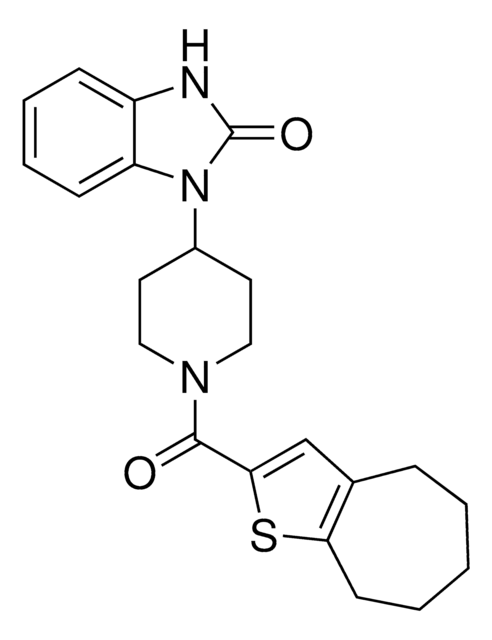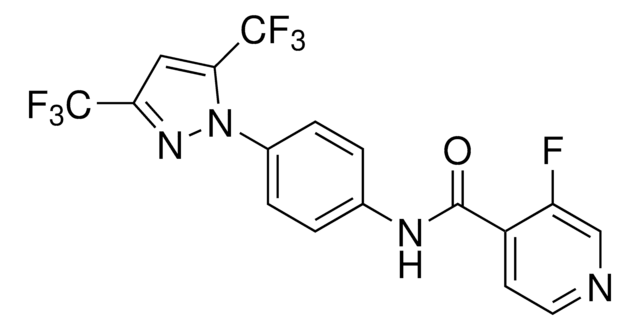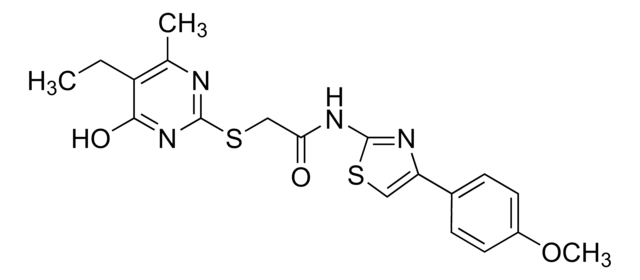P0032
Pyr3
≥98% (HPLC)
Synonym(s):
Ethyl-1-(4-(2,3,3-trichloroacrylamide)phenyl)-5-(trifluoromethyl)-1H-pyrazole-4-carboxylate
Sign Into View Organizational & Contract Pricing
All Photos(1)
About This Item
Empirical Formula (Hill Notation):
C16H11Cl3F3N3O3
Molecular Weight:
456.63
MDL number:
UNSPSC Code:
12352200
PubChem Substance ID:
NACRES:
NA.25
Recommended Products
Quality Level
Assay
≥98% (HPLC)
form
powder
color
white to beige
solubility
DMSO: 20 mg/mL, clear
storage temp.
2-8°C
SMILES string
CCOC(=O)c1cnn(-c2ccc(NC(=O)\C(Cl)=C(\Cl)Cl)cc2)c1C(F)(F)F
InChI
1S/C16H11Cl3F3N3O3/c1-2-28-15(27)10-7-23-25(12(10)16(20,21)22)9-5-3-8(4-6-9)24-14(26)11(17)13(18)19/h3-7H,2H2,1H3,(H,24,26)
InChI key
RZHGONNSASQOAY-UHFFFAOYSA-N
Biochem/physiol Actions
Pyr3 is a pyrazole compound that potently and selectively antagonizes TRPC3. Pyr3 inhibits TRPC3 by binding to the extracellular side of the receptor, resulting in suppression of B cell activation and cardiac hypertrophy.
Members of the canonical transient receptor potential (TRPC) channel family are ion channels which conduct Ca+2 and are activated by membrane receptor-mediated stimulation of phospholipase C (PLC) activity. However, TRPC3 and other family members are also activated by membrane-independent diacylglycerol (DAG). BTP1 and BTP2 are pyrazoles that block TRPC channels, but they are not specific for TRPC subtypes. This channel is implicated in various processes, including B cell receptor (BCR)-mediated Ca+2 oscillations, activation of nuclear factor of activated T cells (NFAT), and promotion of cardiac hypertrophy.
Members of the canonical transient receptor potential (TRPC) channel family are ion channels which conduct Ca+2 and are activated by membrane receptor-mediated stimulation of phospholipase C (PLC) activity. However, TRPC3 and other family members are also activated by membrane-independent diacylglycerol (DAG). BTP1 and BTP2 are pyrazoles that block TRPC channels, but they are not specific for TRPC subtypes. This channel is implicated in various processes, including B cell receptor (BCR)-mediated Ca+2 oscillations, activation of nuclear factor of activated T cells (NFAT), and promotion of cardiac hypertrophy.
Storage Class Code
11 - Combustible Solids
Flash Point(F)
Not applicable
Flash Point(C)
Not applicable
Choose from one of the most recent versions:
Already Own This Product?
Find documentation for the products that you have recently purchased in the Document Library.
Customers Also Viewed
Rongfang He et al.
Oxidative medicine and cellular longevity, 2019, 4025496-4025496 (2019-12-25)
Fibroblast proliferation and migration are central in atrial fibrillation (AF) promoting structure remodeling, which is strongly associated with aging and hypertension. Transient receptor potential canonical-3 channel (TRPC3) is a key mediator of cardiac fibrosis and the pathogenesis of AF. Here
Maria Cristina D Picardo et al.
PLoS biology, 17(2), e2006094-e2006094 (2019-02-23)
Inspiratory breathing movements depend on pre-Bötzinger complex (preBötC) interneurons that express calcium (Ca2+)-activated nonselective cationic current (ICAN) to generate robust neural bursts. Hypothesized to be rhythmogenic, reducing ICAN is predicted to slow down or stop breathing; its contributions to motor
Yi-Fan Wu et al.
Cell & bioscience, 7, 28-28 (2017-05-27)
Chloroquine, a bitter tastant, inhibits Ca In this study, thapsigargin (TG), but not caffeine, induced sustained intracellular Ca These results indicate that chloroquine inhibits Ca
Cheng Cai et al.
Archives of toxicology, 93(4), 1009-1020 (2019-02-27)
Particulate matter (PM) is one of the most important environmental issues worldwide, which is associated with not only pulmonary but also cardiovascular diseases. However, the underlying biological mechanisms of PM related cardiovascular dysfunction remained poorly defined, especially mediated by the
Our team of scientists has experience in all areas of research including Life Science, Material Science, Chemical Synthesis, Chromatography, Analytical and many others.
Contact Technical Service
